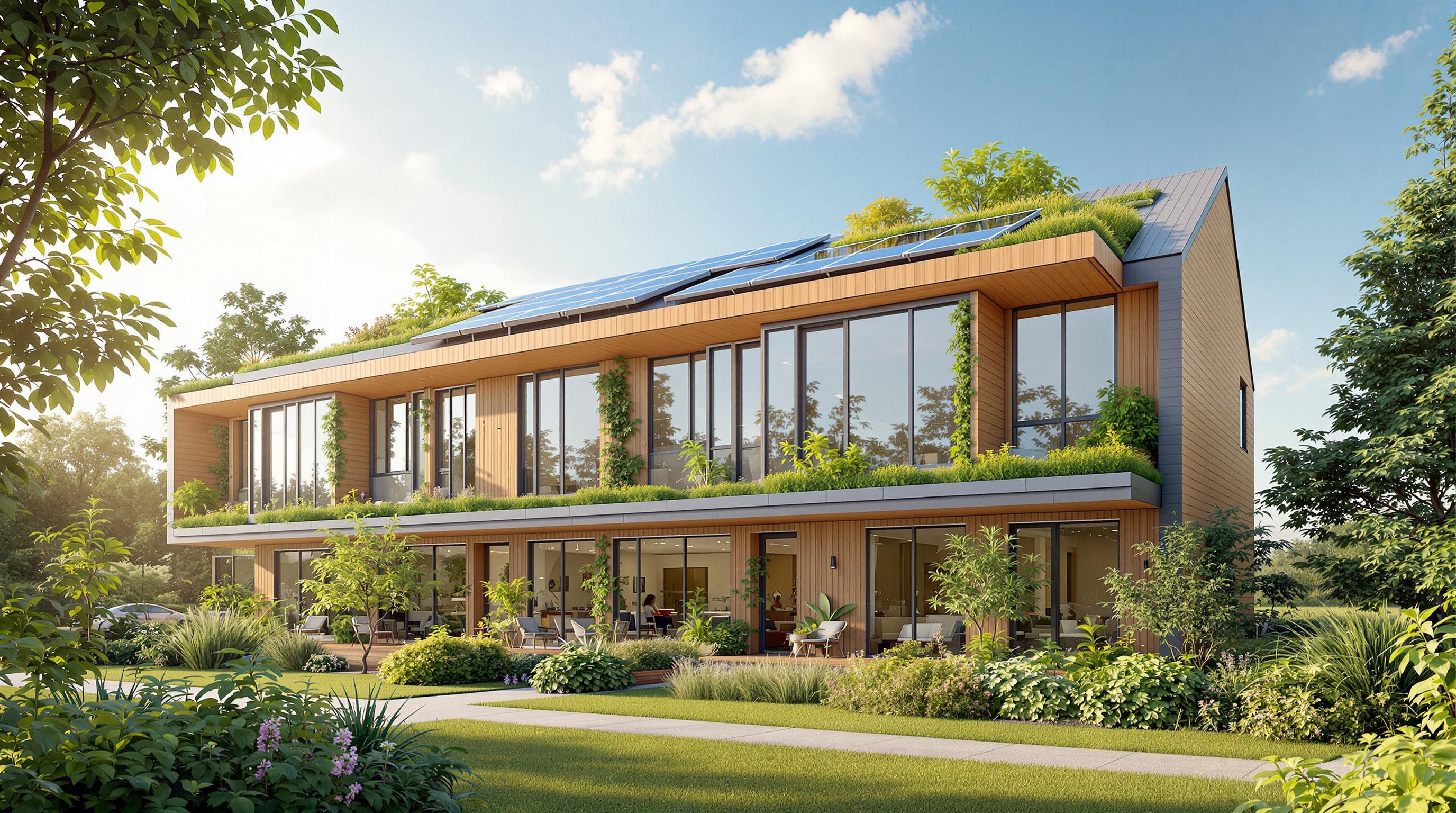Building a home in Nova Scotia is simpler than you might think. Here’s a quick summary of the process:
- Costs: Fixed-price builds start at $168/sq. ft. Typical expenses include land (15–25% of total), construction ($168–184/sq. ft.), permits (1–2%), and land transfer tax (1–1.5%).
- Planning: Define your home’s size, features, and location. Budget carefully and pick a builder with fixed-price contracts.
- Land Selection: Check zoning, utilities, and soil conditions. Review environmental factors like wetlands or flood risks.
- Design & Permits: Use local professionals to create designs that follow Nova Scotia’s building codes. Secure development and building permits.
- Construction: Follow a structured timeline - site prep, foundation, framing, and finishing - while addressing local climate challenges.
- Inspections: Complete required checks for foundation, framing, systems, insulation, and final approval.
- Move-In: Test systems, inspect finishes, and collect warranties before receiving your keys.
Quick Tip: Plan for energy-efficient features like R-22 wall insulation, triple-pane windows, and heat pump systems to save on long-term costs.
Ready to start? Consult with local experts to guide you through the process from planning to move-in.
Step 1: Planning Your Build
Home Requirements
Your home requirements will shape both your budget and timeline. Start by clearly defining your property goals, as location plays a big role in rental income potential.
Key considerations include:
- Typical square footage needs (e.g., a 2-unit duplex might range from 2,000 to 2,400 sq. ft.)
- The number of bedrooms and bathrooms
- Desired features like attached garages or separate entrances
- Location preferences, such as urban or rural settings
Budget Planning
In Nova Scotia, fixed-price builds start at $168 per square foot [1].
Here’s a breakdown of typical costs:
| Cost Category | Typical Range | Notes |
|---|---|---|
| Land Purchase | 15-25% of total | Higher costs in HRM |
| Construction | $168-184/sq. ft. | Includes materials |
| Permits | 1-2% of build | Dependent on municipality |
| Land Transfer Tax | 1-1.5% | Based on purchase price |
"Having a guaranteed price was everything for my first project. Helio took me from day-one design through lease-up, all without the hidden costs I dreaded. I couldn't have asked for a smoother introduction to development." - Michael T., New Developer [1]
With clear goals and a well-structured budget, you’ll be ready to choose a builder who can handle Nova Scotia’s distinct requirements.
Builder Selection
Choose a builder familiar with Nova Scotia’s building codes and one who offers transparent, fixed-price contracts. Opt for a team that integrates design, engineering, and construction services. This kind of collaboration helps avoid delays and miscommunication between contractors.
Step 2: Land Selection
Lot Assessment
When choosing a lot in Nova Scotia, focus on these key aspects:
-
Zoning Requirements
Check local municipal zoning bylaws to understand what’s allowed. Look into permitted uses, setback rules, height restrictions, and lot coverage limits. If you're planning multi-unit or mixed-use projects, confirm that zoning supports them. -
Utility Access
Investigate available utilities. Urban lots often have municipal water, sewer, and power connections. Rural areas might require wells or septic systems. Understand the costs and logistics involved for these services. -
Topography and Soil
Study the land's slope and soil conditions. These factors influence foundation design and can significantly impact construction expenses.
By addressing these points, you'll be better prepared for a smooth and informed purchase process.
Property Checks
Before closing on a property, ensure the following checks are completed:
-
Required Surveys
Secure property surveys, topographical maps, and location certificates to confirm boundaries and assess grading needs. -
Environmental Considerations
Be aware of potential restrictions such as wetlands, coastal setbacks, and flood plains. Examine drainage patterns and any other environmental factors that could affect your plans. -
Nova Scotia Regulations
Familiarize yourself with:- Land transfer taxes
- Coastal protection rules for waterfront properties
- Municipal development restrictions and necessary approvals
-
Development Charges
Account for additional costs like development permits, infrastructure fees, and legal surveys. Your local municipality can provide details about these charges.
For a thorough evaluation, visit the property during different seasons. For instance, a spring visit can help you spot drainage issues caused by melting snow.
Step 3: Design and Permits
Design Process
When designing your home, it's important to match your vision with local rules and your budget. Working with local professionals can help simplify this stage.
Key aspects to focus on:
- Layout Planning: Using pre-designed layouts can save money while meeting building codes.
- Material Choices: Select materials suited to Nova Scotia’s climate, such as proper insulation and weather-resistant finishes.
- Budget Control: Fixed-price contracts can prevent unexpected costs and provide financial clarity during the design phase.
Once your design is ready, the next step is to handle Nova Scotia's permit requirements.
Nova Scotia Permits
Obtaining the right permits is essential and usually involves several steps with local authorities. Here's a breakdown of the main permits you'll need:
Development Permits
These confirm you’re allowed to build on the property and meet zoning rules. Processing times differ depending on the municipality.
Building Permits
Before starting construction, you’ll need a building permit to ensure your plans align with the Nova Scotia Building Code. This includes checks for:
- Structural strength
- Energy efficiency standards
- Fire safety features
- Accessibility compliance
Permit Documents
Submitting a complete application package is key to avoiding delays. Here’s what you’ll typically need:
| Document Type | Purpose | Typical Processing Time |
|---|---|---|
| Architectural Drawings | Outlines construction details | 2–3 weeks for review |
| Site Plans | Maps property layout and setbacks | 1–2 weeks for review |
| Engineering Reports | Verifies structural soundness | 2–4 weeks for review |
To speed things up, consider working with firms that combine design, engineering, and permitting services. This approach can streamline the process and ensure all documents meet local standards. For instance, Helio successfully used this method for a 3,200 sq. ft. duplex near Truro. The project moved smoothly through the permitting process and was appraised at about $830,000 [1].
New Construction in Halifax Part One. How Much Does It Cost ...
sbb-itb-16b8a48
Step 4: Building Process
Once permits are approved, it's time to start construction. This phase follows a structured process to lay the groundwork and build your home.
Construction Steps
-
Site Preparation & Foundation
Preparing the site is crucial, especially in Nova Scotia, where soil and weather conditions can vary significantly. Once the site is ready, the foundation is poured and waterproofed to handle moisture and coastal climate challenges. -
Framing & Exterior
This step includes setting up floor joists, wall frames, and roof trusses, followed by adding sheathing, weather barriers, windows, and doors.
These steps are tailored to meet Nova Scotia's specific environmental requirements, as outlined below.
Nova Scotia Factors
Local construction experience highlights the need for weather-resistant materials and strict adherence to timelines [1]. Nova Scotia's changing seasons demand construction methods designed to handle the region's unique challenges.
| Construction Phase | Nova Scotia Considerations | Impact on Build |
|---|---|---|
| Foundation | Frost protection is essential | May require deeper foundations |
| Exterior Finishing | Salt air resistance is crucial | Requires specially chosen materials |
| Insulation | Higher R-value is necessary | Improves energy efficiency |
Build Schedule
A clear timeline is key to keeping the project on track. Once the site prep, foundation, and framing are complete, the rest of the work follows a structured schedule.
"Every day of delay was a lost rent check. Helio's in-house crew kept the timeline on track, so I started collecting rent a full month earlier than I expected!"
– Daniel T., First-Time Duplex Investor [1]
Typical Construction Timeline:
-
Foundation Stage
This phase, which includes excavation, forming, and concrete work, generally takes 2–3 weeks. -
Framing to Lock-Up
Completing the exterior shell takes about 6–8 weeks. -
Interior Finishing
Installing systems and adding final touches takes 12–16 weeks.
Step 5: Inspections
Required Checks
Inspections ensure your home complies with Nova Scotia's building codes and safety standards, safeguarding your investment throughout the process.
Here are the common inspection stages during construction:
| Stage | Inspection Focus | Timing |
|---|---|---|
| Foundation | Footings, waterproofing, and drainage | Before backfill |
| Framing | Structural elements and sheathing | Before interior finishes |
| Systems | Plumbing, electrical, and HVAC systems | Before drywall |
| Insulation | R-values and vapour barriers | Before insulation is covered |
| Final | Comprehensive review for code compliance | Before occupancy |
Working with a design-build team can streamline this process, addressing any issues identified during inspections quickly and efficiently.
"On my last project, each sub blamed the other. With Helio, any hiccup was fixed in-house - no finger-pointing." – Michael T. [1]
Final Approval
Once all inspection stages are completed successfully, your home will receive its occupancy permit. This signifies that the building systems, structure, and overall construction meet local codes. A fixed-price contract can help ensure work is done promptly and correctly, avoiding unnecessary delays.
Step 6: Moving In
Once the final inspections are done and you have your occupancy permit, it's time to move in.
Pre-Move Checklist
Before settling in, do a final walkthrough with your builder to ensure everything meets the agreed-upon standards. Pay close attention to the following:
| Area | What to Check |
|---|---|
| Systems | Test appliances, HVAC systems, and plumbing fixtures |
| Structure | Look for defects in walls, floors, and windows |
| Exterior | Check landscaping, drainage, and outdoor fixtures |
| Documentation | Collect warranties, manuals, and maintenance guides |
Take detailed notes and photos of any issues to ensure they’re resolved quickly. Once everything is addressed, you can move forward with the final handover.
Completion Steps
After resolving any issues identified during the walkthrough, the final key handover confirms your home is ready. Helio Urban Development ensures this process runs smoothly, guiding you through every step.
"We walk you through your finished units. Start renting right away - and celebrate your smart investment!" [1]
For those with investment properties, this thorough review ensures your unit is ready for tenants, helping you start earning rental income immediately [1].
Building Tips
Once you have your build plan ready, you can take some extra steps to improve performance and keep your project on schedule.
Energy Savings
Choosing smart designs and high-quality materials can lead to long-term savings on energy costs.
| Feature | Advantage |
|---|---|
| R-22 Wall Insulation | Boosts energy efficiency |
| Triple-Pane Windows | Reduces heat loss, improving insulation |
| Heat Pump System | Provides efficient and effective heating |
Making thoughtful decisions about insulation, windows, and heating systems can significantly improve your building's energy performance.
Timing Your Build
Good timing is critical when it comes to avoiding delays and managing costs, especially in Nova Scotia's changing weather:
- Submit permit applications during the colder months to prepare for spring construction.
- Start foundation work once the frost has thawed.
- Schedule framing for periods of favourable weather.
- Plan interior work for times when conditions can be controlled.
Weather Considerations:
- Pour concrete when temperatures are suitable.
- Finish roofing before winter sets in.
- Allow for extra time if working during winter months.
Next Steps
Here’s how our process works, step by step:
| Stage | What Happens |
|---|---|
| Initial Consultation | We assess your lot, check zoning, and plan your budget. |
| Contract Phase | A fixed-price agreement is signed, locking in your $/ft² rate. |
| Project Launch | Final designs are approved, and permits are submitted. |
| Construction | You’ll receive regular updates and track milestones. |
Our approach has delivered consistent results. For example, projects in Colchester have achieved excellent returns. Plus, with AI-optimized scheduling, we’ve kept over 30 multi-unit builds on time and within budget [1].
Ready to get started? Book a free consultation to review your lot, confirm zoning, secure your rate, and kick off your project. From design to construction, we’ll keep you informed every step of the way. Let’s bring your vision to life!
Related posts
- Navigating Nova Scotia Building Permits and Approvals: A Step-by-Step Guide
- Building on the Eastern Shore: Guide to Musquodoboit Harbour, Sheet Harbour & Surroundings
- How Much Does It Really Cost to Build a Custom Home in Nova Scotia?
- Small Multi-Unit Development 101: Building Duplexes and Fourplexes in Nova Scotia



